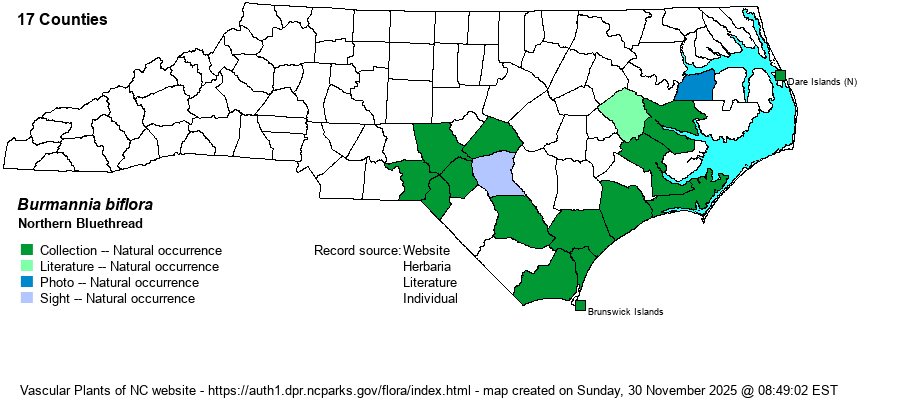| Author | L. | |
| Distribution | Found across much of the southern half of the Coastal Plain, both coastally and into the Sandhills region. Ranges north to northern Dare, Beaufort, Pitt, Harnett, and Moore counties. However, there are records for nearby VA counties and thus it might be present in NC's northern Coastal Plain. A 2021 photograph was taken at "Pocosin Natural Area" in Washington County.
This is a Southern species that ranges north to southeastern VA, and south to southern FL and west to AR and TX.
| |
| Abundance | In the coastal counties from Craven/Carteret (i.e., Croatan National Forest) south to Brunswick, it is uncommon to locally fairly common (in protected and managed sites); uncommon and scattered in the Sandhills. However, rare to absent in many of the south-central counties (Sampson, Duplin, Wayne, etc.), where suitable habitat in the form of savannas and sandhills seeps are very rare or not present. Thus, the range map is not an artifact of collecting, but indicates two regions of occurrance. This is a Watch List species, as identified by the NCNHP. | |
| Habitat | This species is found in wet soil with little competition, owing to its tiny size. It can be found around wet depressions or pool margins, openings in savannas, sandhills seepages, and shores of various natural and artificial ponds. Most of its habitats are in natural settings as opposed to scrapes and ditches; it favors full sun at its sites. | |
| Phenology | Blooms and fruits from August to November. | |
| Identification | This is one of the smallest of our vascular plants, especially of savannas and pool margins. It has a very slender (almost thread-like) stem that grows only to about 3-4 inches high, with a few tiny scale-like leaves along it (though leaves are practically invisible). The odd flowers are violet-blue; there are usually several atop the stem. In actuality, it has extremely small white petals/sepals, and it is the ovary that is colored blue, with three broad wings; the flower is about 1/4-inch tall and broad. When in fruit, the plant looks essentially as in bloom, as the ovary is the colored part of the flower. There is no other plant that looks like Northern Bluethread, but this is a classic "belly plant", as to see it well or to photograph it you will need to be on your knees or stomach! If you spend time walking around one or two well-managed savannas in the lower Coastal Plain, you might be able to encounter a few of these remarkable plants; however, they do not grow in sizable colonies, typically just a few plants scattered on the landscape. | |
| Taxonomic Comments | None
| |
| Other Common Name(s) | Violet Burmannia, Blue Burmannia | |
| State Rank | S2S3 | |
| Global Rank | G4G5 | |
| State Status | W1 | |
| US Status | | |
| USACE-agcp | OBL link |
| USACE-emp | OBL link |

